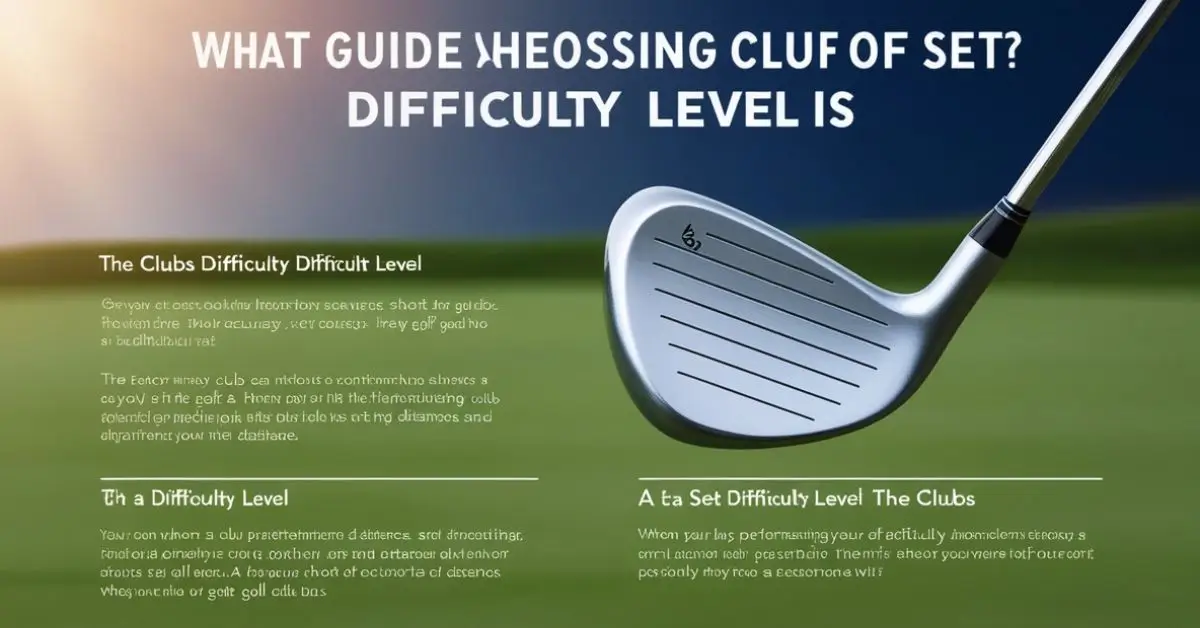How to Know the Difficulty of a Set of Clubs. When choosing a set of golf clubs, understanding their difficulty level is essential for optimizing performance. The right clubs can enhance control, distance, and accuracy, while a mismatched set may lead to inconsistent shots and frustration. This guide explores the key factors determining a club’s difficulty, helping golfers of all skill levels make informed decisions.
Understanding Golf Club Difficulty
The difficulty of a set of clubs is influenced by design, materials, and technical specifications. Several elements affect playability, including clubhead design, shaft flexibility, loft angle, and grip size. Recognizing these factors allows players to select clubs that complement their abilities and playing style.
Factors Influencing Golf Club Difficulty
1. Clubhead Design
Blade Irons vs. Cavity Back Irons
- Blade Irons: Known as muscle-back irons, these clubs feature a thinner clubhead with a smaller sweet spot. They provide excellent control and shot-shaping abilities but are unforgiving on off-center hits. This makes them ideal for experienced golfers who prioritize precision over forgiveness.
- Cavity Back Irons: These clubs have a hollowed-out back, redistributing weight to the perimeter. The design increases forgiveness by reducing mishits, making them a suitable choice for beginners and intermediate players.
Game-Improvement Irons
These irons have larger clubheads, wider soles, and a lower center of gravity, making them easier to hit. They enhance distance and consistency, helping high-handicap golfers gain confidence in their swings.
2. Shaft Flexibility
The shaft’s flexibility significantly impacts ball trajectory, spin, and overall performance. The main flex categories include:
- Extra Stiff (X-Flex): Used by players with high swing speeds (over 105 mph), providing lower ball flight and enhanced accuracy.
- Stiff (S-Flex): Suitable for golfers with swing speeds between 95–105 mph, offering a blend of power and control.
- Regular (R-Flex): Designed for those with moderate swing speeds (85–95 mph), providing a balance between flexibility and stability.
- Senior (A-Flex): Helps players with slower swing speeds (75–85 mph) generate more distance.
- Ladies (L-Flex): Maximizes clubhead speed and launch angle for those with swing speeds below 75 mph.
Choosing the right shaft flex ensures proper energy transfer, reducing the likelihood of errant shots.
3. Loft Angle
The loft angle dictates ball trajectory and distance. Lower-lofted clubs produce lower ball flights with more roll, while higher-lofted clubs create steeper launch angles.
| Club Type | Typical Loft Angle (Degrees) | Effect |
|---|---|---|
| Driver | 8–12 | Low trajectory, maximum distance |
| 3-Iron | 19–21 | Long distance, challenging to hit |
| 7-Iron | 34–37 | Moderate trajectory, control and accuracy |
| 9-Iron | 40–44 | High trajectory, increased stopping power |
| Wedges | 46–64 | High launch, optimal for short-game precision |
Beginners may struggle with lower-lofted clubs, as they require higher swing speeds for optimal performance. Higher-lofted clubs provide greater forgiveness and are easier to control.
4. Club Length and Weight
Longer clubs increase swing arc and generate greater power, but they also require more control. Shorter clubs, such as wedges, offer better accuracy but less distance.
- Drivers and Fairway Woods: Longer shafts (43–46 inches) maximize distance but demand precise timing.
- Irons: Mid-length shafts (35–39 inches) balance power and control.
- Wedges: Shortest shafts (33–36 inches) provide accuracy for approach shots.
Club weight also influences difficulty. Heavier clubs require more strength to swing effectively, while lighter clubs enhance speed but may sacrifice control.
5. Grip Thickness
Grip size affects hand positioning and swing mechanics.
- Thin Grips: Allow more wrist action, benefiting players who rely on feel and shot creativity.
- Thick Grips: Limit hand movement, reducing the chances of over-rotating the clubface.
Choosing a grip that suits hand size ensures a comfortable hold and improves shot consistency.
Assessing Club Difficulty Based on Skill Level
The best way to gauge the difficulty of a club set is by matching it to a golfer’s skill level.
Beginner Golfers
- Prioritize forgiveness over shot-shaping ability.
- Opt for cavity back or game-improvement irons.
- Use graphite shafts for lightweight performance.
- Choose higher-lofted drivers and fairway woods for easier launch.
Intermediate Golfers
- Experiment with a mix of cavity back and player’s irons.
- Consider steel shafts for added control.
- Select clubs that balance forgiveness and workability.
Advanced Golfers
- Prefer blade irons for maximum shot control.
- Utilize stiff or extra-stiff shafts.
- Choose lower-lofted clubs for greater distance.
- Optimize wedge selection for versatility around the green.
Comparison Chart: Club Types and Difficulty Levels
| Club Type | Features | Difficulty Level | Ideal Skill Level |
|---|---|---|---|
| Blade Irons | Small sweet spot, high shot control | High | Advanced |
| Cavity Back Irons | Forgiving, perimeter weighting | Medium | Beginner–Intermediate |
| Game-Improvement Irons | Large clubhead, easy to hit | Low | Beginner |
| Hybrid Clubs | Combines iron and wood features, versatile | Low | All Levels |
| Drivers | Longest club, low loft | High | Intermediate–Advanced |
| Wedges | High loft, short shaft | Low | All Levels |
This comparison highlights how different club types cater to varying skill levels and playing styles.
How to Test a Set of Clubs
1. Visit a Golf Store or Driving Range
Testing clubs before purchasing provides real-world insights into their performance. Pay attention to:
- Feel and comfort during swings.
- Ball trajectory and spin rate.
- Distance consistency.
2. Use a Launch Monitor
Launch monitors analyze swing speed, ball speed, and spin rates, offering precise data on club performance.
3. Seek Professional Club Fitting
A club fitting session tailors equipment to an individual’s swing characteristics, optimizing club selection.
Common Mistakes When Choosing Clubs
1. Prioritizing Brand Over Fit
A well-known brand doesn’t guarantee better performance. Clubs should match skill level and playing needs.
2. Ignoring Shaft Flex
Using an incorrect shaft flex can lead to inconsistent shots. Always test different options before deciding.
3. Choosing Clubs That Are Too Advanced
Beginners using blade irons may struggle with shot consistency, leading to frustration. Starting with game-improvement clubs builds confidence and skill progression.
4. Overlooking Grip Size
An uncomfortable grip affects swing mechanics. Ensuring proper grip thickness enhances control.
Conclusion
Determining the difficulty of a set of clubs requires a balance between skill level, swing mechanics, and club characteristics. By understanding factors like clubhead design, shaft flexibility, loft angle, and grip size, golfers can make informed choices that enhance their performance.
Testing clubs, consulting professionals, and avoiding common selection mistakes will ensure that the right set complements one’s playing style. Whether a beginner seeking forgiveness or an advanced player refining control, selecting the correct clubs makes a significant impact on the game.
For a visual explanation of selecting golf clubs, check out this helpful video: How to Choose the Right Golf Club











